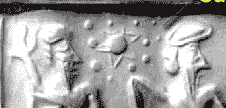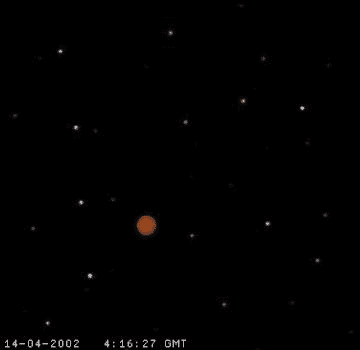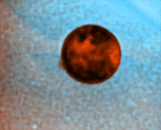
The Sumerians saw it. The Russians photographed it. NASA saw it, too. And now, eons after it left our world behind as a smoking, lifeless mess, the dreaded Planet X is about to reenter our solar system and mess up our world all over again. Or is it?
The demon planet that is supposed to do the trick goes by many names. Some call it Nibiru, or Marduk. Others named it The Ottawa Object, or Vulcan, or Transpluto. But most people prefer X, just X. `Planet X’, to be precise.
Planet X is the supposedly eleventh planet of our solar system. It should be as big as many Earths, dwarfing it perhaps even hundreds of times. Some people think X isn’t even a real planet, but a `brown dwarf’: a massive ball of dust and gas that almost succeeded in becoming a star. Planet X has something no other planet has: a huge orbit. Its orbit around the Sun lasts 3,600 years. Most of the time, it is far off, invisible to the eye. But every 3,600 years, the lost planet returns. Once here, it accelerates, and swings close past the Sun, disrupting everything it encounters.
And that’s exactly what Planet X is about to do, they say. Right now, it should be somewhere in the outer regions of the solar system, still invisible to our telescopes. But in the spring of 2003, it will suddenly make its appearance. It will be some event. Within months, Planet X will reach the inner regions of the solar system, disturbing the eclipses of the planets and bombarding us with comets. In May, it will pass Earth, missing it only at a few hairs’ lengths. Or, well: hitting us at full force, perhaps.
And that will be it. X will fly off again, not to be seen for another 3,600 years. And our planet? Earth will be bruised and battered, and covered in lava. If there’s anything worth calling a planet left at all, that is.
Planet X: The Real Story
Then again, maybe nothing happens at all in 2003. You see, Planet X is like the perfect myth: the outcome of centuries of ill-omened rumors, laced with snippets of history and cosmology. But: it is still myth. Dream stuff.
It all began with a tablet of clay, uncovered in the Near East many years ago. On the tablet, the Sumerians, the earliest known inhabitants of the Middle East, jotted down something that looked like a solar system. Earth was there, and Saturn, and Jupiter -- as well as all other planets we know of today. But hey, aren’t there supposed to be nine planets? The clay tablet clearly displays eleven. The tenth one could be the moon, or the newly discovered mini-planet Sedna. But that still leaves you with one planet too many. Weird, isn’t it?
 |
|
|
Next came the astronomers. From the 1840s until deep into the 1980s, astronomy was haunted by a strange mystery. Something was not right with the orbits of the outer planets. Something really heavy seemed to be tugging at the outer planets Uranus and Neptune. Certain asteroids felt the mysterious pull, too. Must be an enormous planet out there, many astronomers assumed. Or several planets, even. This was how Planet X got its name: the term `X’ comes from the early-twentieth century astronomer Percival Lowell, best known for his study of the `canals’ on Mars.
But eventually, in the 1980s and 1990s, the riddle was solved. There appeared to be no mystery planet involved at all. Neither is there some mysterious force pulling on Neptune’s orbit. The astronomers simply had their orbit calculations wrong. But with better techniques, it all added up. By now, no serious astronomer believes in Planet X anymore. Exit Planet X.
But it was too late already. The Planet X-story had started to lead a life of its own. The breakthrough came in 1976, when a new age-writer by the name of Zecharia Sitchin linked the Planet X-problem of the astronomers up with Sumerian and Babylonian mythology.
Enter Sumerian religion. Like most people, the Sumerians had a lot of pretty neat stories about how the Earth came about. In one of them, it all began with a family quarrel between two gods, Tiamat and Marduk. The two picked a fight, and Marduk won. Pissed off as he was, Marduk cut Tiamat to bits. From the body parts he created our world. This leg here is the sky; that arm there, that'll be the land.
But Sitchin turned the story upside-down. To his opinion, the Sumerians were actually describing an ancient cosmic disaster. A collision between our own planet (Tiamat), and Marduk -- which was, of course, the mystery planet from the clay tablet, a.k.a. Planet X. Adds up nice, right?
Well: it doesn't. For one thing, Sitchin's translations of the Sumerian texts were terrible - for example, he got the word for `planet' wrong. And the words Nibiru and Marduk? Marduk was, besides a god, a nickname for the planet Jupiter. `Nibiru' simply means `ferry boat' and was sometimes used to describe... Jupiter! So in fact, what Sitchin holds for Planet X is simply good old Jupiter.
The astronomical side of the story is no good, either. A planet with a highly elliptic orbit of 3,600 years would after a few rotations fly off, direction deep space - or just become part of the 'normal' solar system. It is simply impossible there is a Planet X around. Physics forbids it, just like it forbids apples from falling upwards.
But how about the ten planets on the Sumerian tablet? That's decoration, probably. Or it could be Venus, as seen from Earth, and surrounded by stars. There are many, many clay tablets exactly like this one, and they all display funny little drawings in the corners: crosses, moons, stars -- you name it. So there's no need to think anything special of the `planets'. We can be sure of one thing, though: it isn't a astronomical map. The Sumerians believed our planet was a flat disc, they didn't believe the planets rotated around the Sun, and they had no way of seeing the outer planets Neptune, Pluto and Quaovar.
Still, Sitchins book was a bestseller, and Planet X gained quite a following on Earth. It still has. Some believe Planet X is an inhabited planet, inhabited by Atlantians, or pyramid-builders, or little green men, or... well, you know, that sort of thing. Even today, there are people around who claim they are in `telepathic contact’ with the inhabitants of the planet. Sigh... Some people will simply believe anything!
Aw... Hold it now. Is that all? Well, there’s this other thing. For in fact, Planet X has been spotted by NASA! In 1983, two astronomers named Neugebauer and Houck made headlines with their announcement that they had discovered a `Jupiter-sized planet’, cruising the galaxy at a distance of two billion kilometers from the Sun.
But: the headlines were wrong. What Neugebauer and Houck really told the press was that they discovered an irregularity in the infrared spectrum. It could be almost anything, they stated, ranging from a new planet to a distant galaxy. The press obviously preferred the planet. But after a while it became clear that what the astronomers really saw was a distant galaxy.
By now, numerous pictures, news clippings and remarkable facts `proving’ the existence of the dreaded Planet X are circulating the Net. But don’t stock on tin cans: they're all bogus (for the details, check out the fact sheet at the bottom of this page).
It is at this point many Planet X-believers resort to gossip and childish, X-filish conspiracy theory. According to one particular rumor, the astronomers hold back all information regarding Nibiru. The Russians would have taken photos of Planet X, including affirmed alien space ships hovering over its surface (see pictures below). Another rumor has it the coming of Planet X is covered up by hushy governments -- isn’t that why so many observatories are closed down for maintenance? Oh, sure! You must have a Sumerian clay tablet for a brain to buy stuff like that!
So: Planet-Ex?
You guessed it. If they ever start telling you about Planet-X, laugh your wits off. Don’t take any precautions – there’s no need. Planet X doesn’t exist. Never has. Never will. Off with you, Nibiru. Shoo.
[ Credit: For the Sumerian part of the story, Exit Mundi owes a great deal to Wilfred van Soldt, an expert on Mesopotamian astronomy at Leiden University who was willing to look into the case. Also, Exit Mundi consulted Frank Israel, an astronomer at the same university. The insight they offered is invaluable, thanks! ]
|
|
|
|
|
|
|
|
|








